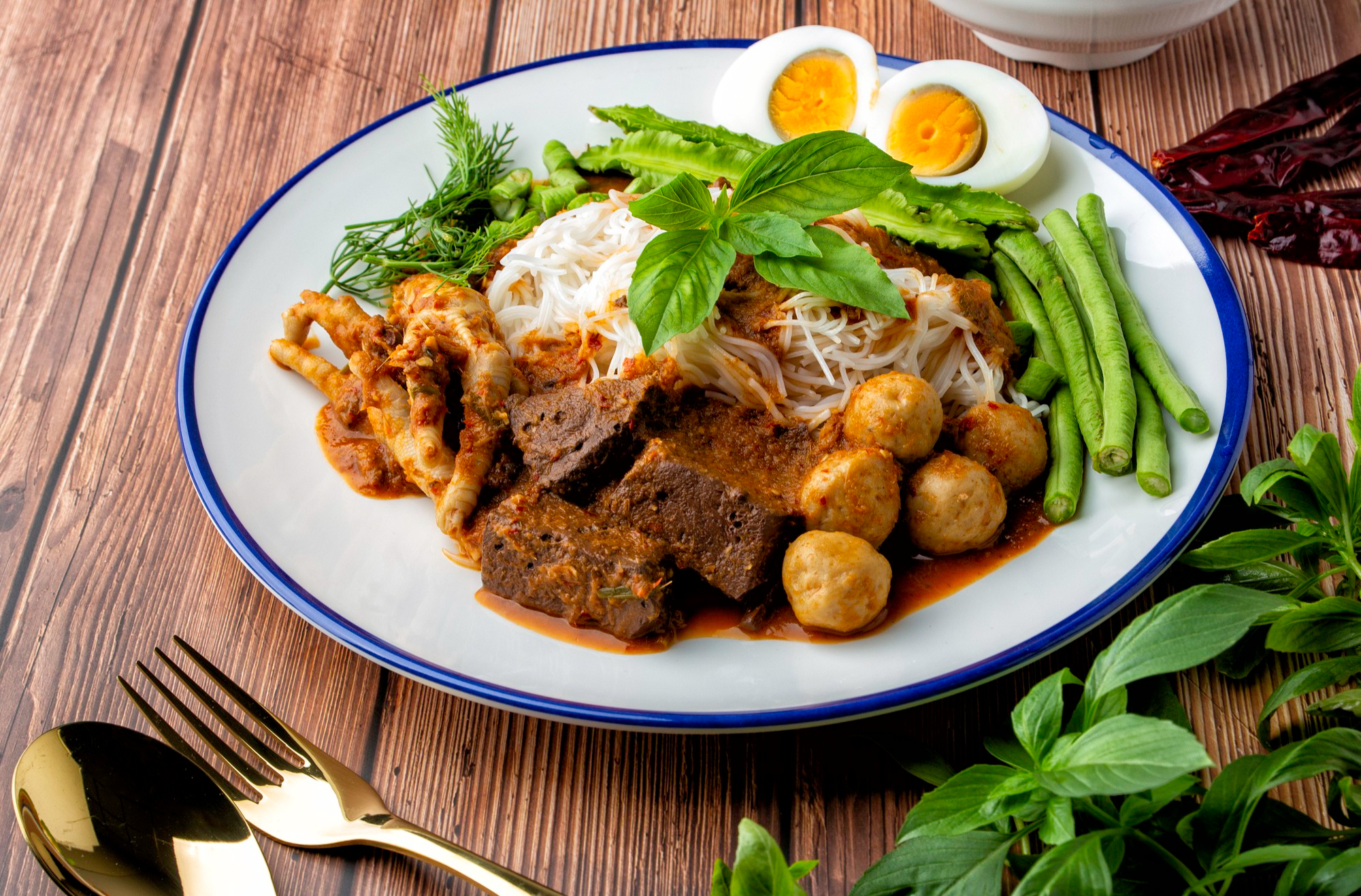In Thailand, rice is typically served with curries, while noodles are typically found in fried foods (like the popular pad thai). The exception is this street food, where Kanom jeen noodles are offered with a choice of many different curries and a variety of seasonings to suit individual preferences.
Finding Kanom jeen vendors in Thailand is quite simple since they always have lovely coils of rice noodles spread out next to huge pots of curries and heaps of vegetables, ready to be mixed together at a moment’s notice.
When ordering, it can be a little overwhelming because you can choose from a wide range of add-ons, including vegetables like cabbage, bean sprouts, long beans, and banana blossoms, as well as fruits like green mango and pineapple and various pickled or coconut-braised vegetables. You can also choose from the curry selection to go with your noodles.
Nam ya style curry, a coconut-based fish dish produced by boiling fish and aromatic seasonings in coconut milk and mixing the mixture to create a thick, noodle-coating sauce, is one of the most well-liked curries paired with Kanom jeen.
There are two main types of Nam ya curry, one from Thailand’s southern region and the other from its central plains. The central plains version contains salted fish (pla goo lao), freshwater fish like snakehead fish (pla chaawn), a moderately spicy dried spur chili (prik cheefa), and a lot of grachai. The southern variation of the dish is more spicy in relation to the central plains variation. Its yellow colour is due to the addition of smaller, hotter chilies, black pepper, and fresh turmeric, as well as the use of saltwater fish like mackerel or barracuda to thicken the curry. Grachai is not included in this version of Nam ya curry.
Making the curry
Nam ya curry doesn’t begin by making a paste from fresh ingredients in a mortar and pestle like other curries you may be familiar with. The ingredients are instead roughly chopped and boiled with fresh fish in coconut milk that has been diluted with water to resemble hang gati, the “tail,” or the second or third pressing of coconut milk. Hang gati is much lighter and has a more subtle flavor than the rich and thick hua gati, or “head,” of coconut milk. The fish and aromatics are taken off the heat after simmering and pounded separately in a mortar and pestle (you can also use a food processor or blender for this) until the fish has a crumbly texture and the aromatics have been reduced to a paste. They are then added to the simmering liquid along with additional coconut milk and fish sauce to create the final curry.
Ingredients
For the Curry:
- 3 cups full-fat coconut milk
- 7 stalks lemongrass, bottom 4 to 5 inches only, tender core sliced into 1/4-inch-thick rounds
- 12 pieces grachai, cut into 1/4-inch-thick rounds
- 6 small shallots
- 5 medium-size garlic cloves
- One fresh galangal, peeled and thinly sliced
- 1 tablespoon makrut lime zest
- 15 dried Thai chilies, stemmed
- 10 dried spur chili, stemmed and seeded
- 2 tablespoons Thai shrimp paste
- 2 teaspoons salt
- 115g bone-in mackerel steaks
- 1/4 cup plus 2 tablespoons fish sauce
For Serving:
- 300g dried thin rice noodles (vermicelli)
- Assorted raw vegetables, such as green cabbage, cucumbers, long beans, and banana blossom (all thinly sliced), mung bean sprouts
- Soft-boiled eggs, for serving (optional)
- Fresh sweet basil leaves (a.k.a. Thai basil), for serving
Directions
- To make the curry: Combine 4 cups of water and 2 cups of coconut milk in a 3-quart saucepan. Add the following ingredients: mackerel, lemongrass, grachai, shallots, garlic, galangal, both types of dried chilies, and shrimp paste. Over medium-high heat, stir everything together and bring to a boil. For about 10 minutes, cook the fish at a boil while stirring occasionally. Fish should be moved to a dish and left to cool using a slotted spoon.
- Return the pan to the heat and cook for another 10 to 15 minutes, or until the liquid is reduced to about 3 cups. Blend the contents of the saucepan at high speed for 1 to 2 minutes, until they are smooth. Wipe out the pan and put it back on the stovetop. Curry that has been mixed is set aside.
- Pick the fish meat from the bones with clean hands and place it in a food processor or mortar and pestle. Discard the bones and skin. For about a minute, pound or pulse fish until it resembles cooked ground meat.
- Return the fish and curry to the saucepan, along with the remaining 1 cup coconut milk, fish sauce, and 1/2 cup water. Stir everything together and bring to a boil over medium-high heat. Cook, stirring occasionally, until the curry thickens to a saucy consistency, about 20 minutes.
- For serving: In the meantime, heat a saucepan of water to a boil. Add the noodles and simmer for about 7 minutes, stirring periodically, until just tender (cooking time varies for vermicelli, so start checking for doneness after 3 minutes). Drain and then run a cold water rinse. Noodles should be moved to a big serving platter or to individual plates. Pass veggies, eggs, sweet basil, and curry at the table for diners to garnish their dishes with as they wish. Serve.
